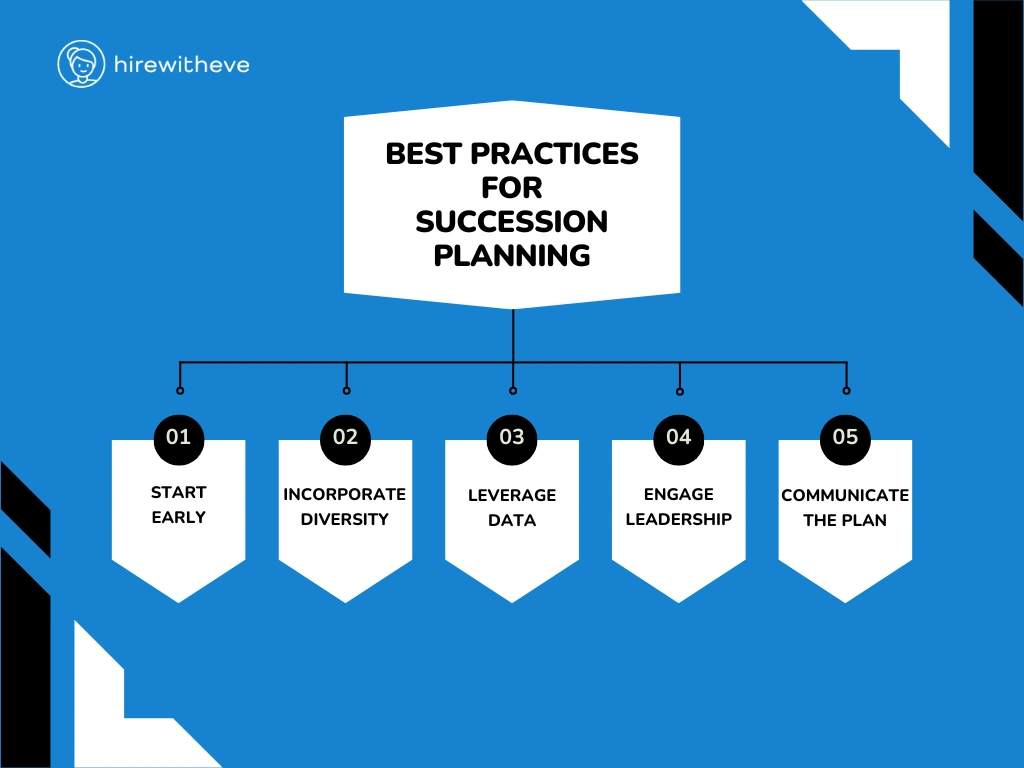Best Practices for Succession Planning
Best Practices for Succession Planning

In today’s rapidly changing business landscape, the need for a well-structured succession planning process has never been more critical. Companies are facing increased turnover, evolving workforce dynamics, and an aging population of leaders. Succession planning ensures that organizations are prepared for the inevitable — whether it’s the retirement of a key executive, the departure of a critical team leader, or any other leadership transitions that could impact operations.
Succession planning is not just about identifying replacements for top positions; it’s about strategically preparing for the future and ensuring that your talent pipeline is robust enough to withstand shifts in the market and organizational structure.
This blog will guide talent acquisition specialists and HR managers through the importance of succession planning and the best practices for building a future-proof workforce.
Table of contents
Why Succession Planning is Critical?
Succession planning provides a framework for organizations to ensure they are prepared for any potential leadership gaps. Without proper succession planning, companies risk losing critical knowledge and leadership continuity.
Here are some reasons why succession planning is a must-have for organizations:
Leadership Continuity: The primary goal of succession planning is to ensure the smooth transition of leadership when key positions become vacant. A well-prepared plan minimizes disruption and ensures business operations continue without setbacks.
Talent Development: Succession planning allows companies to groom and develop internal talent. By identifying potential leaders early, organizations can provide them with the necessary skills and experiences to be successful in their future roles.
Employee Retention: Succession planning helps improve employee retention by showing employees a clear pathway to leadership. Employees are more likely to stay with a company if they see opportunities for growth and leadership development.
Risk Management: Succession planning mitigates the risks of having unprepared or unqualified individuals step into critical roles during unforeseen transitions. A strong succession planning process allows HR managers and talent acquisition specialists to identify, train, and retain key employees before they’re needed.
What are the Key Components of Effective Succession Planning?
Succession planning goes beyond merely identifying potential candidates. A well-rounded plan must consider the company’s long-term strategy, existing talent capabilities, and areas for growth.
Below are the key components of effective succession planning:
Assessing Leadership Needs: Organizations must first evaluate their current and future leadership needs. This requires an understanding of the business’s strategic objectives and how those goals might impact the workforce in the years ahead.
Talent Identification: Identifying high-potential employees is at the core of succession planning. This process often involves evaluating current employees based on their skills, performance, leadership qualities, and ability to adapt to change.
Skill Development and Training: Succession planning also focuses on developing future leaders through targeted training and development programs. Providing employees with leadership training, mentorship opportunities, and stretch assignments prepares them for potential future roles.
Succession Planning Metrics: Organizations must establish clear KPIs to measure the success of their succession planning efforts. Metrics such as the rate of internal promotions, leadership retention, and readiness of successors can help track the effectiveness of succession planning.
Regular Review and Update: Succession planning is not a one-time event. To remain relevant, the plan must be reviewed and updated regularly to reflect changes in the company’s structure, market conditions, or leadership needs.
What are the Challenges in Succession Planning?
While the benefits of succession planning are clear, implementing a successful plan is not without challenges. Talent acquisition specialists and HR managers often face the following issues when it comes to succession planning:
Bias in Talent Selection: Succession planning requires objective assessments of talent. HR managers must guard against biases that could lead to the wrong individuals being placed in leadership development programs.
Lack of Resources: Succession planning can be resource-intensive, requiring time, training programs, and ongoing development initiatives. Smaller organizations may struggle with the resources needed to implement a comprehensive succession planning strategy.
Resistance to Change: Employees or current leaders may resist succession planning initiatives, either due to fear of being replaced or a reluctance to invest in long-term leadership development. HR must work to overcome these cultural barriers.
Inadequate Development Opportunities: Succession planning is only effective when high-potential employees are allowed to grow and develop. A lack of training programs or mentorship opportunities can stall the succession planning process.
What are the Best Practices for Succession Planning?
To overcome challenges and maximize the effectiveness of succession planning, HR managers and talent acquisition specialists should follow these best practices:

Start Early: Succession planning should not wait until leadership vacancies are imminent. Start the process early to give candidates enough time to develop the skills necessary for leadership roles.
Incorporate Diversity: A strong succession planning process includes diverse talent at every level. Diverse perspectives are crucial to developing innovative leaders who can navigate complex and global business challenges.
Leverage Data: Use data analytics to make informed decisions about which employees should be part of the succession pipeline. Track performance, skill progression, and potential for leadership growth using measurable data points.
Engage Leadership: Top executives should be involved in succession planning. Their insights into business needs and leadership qualities can help guide the identification and development of future leaders.
Communicate the Plan: Keep employees informed about succession planning initiatives. By being transparent about opportunities for growth and advancement, you can increase engagement and retention among high-potential employees.
Conclusion
Succession planning is a vital tool for any organization looking to ensure long-term leadership success. For talent acquisition specialists and HR managers, the right tools can make all the difference in creating an effective succession plan. HirewithEve provides the following features that can assist in your succession planning efforts:
Skills-Based Assessment: With HirewithEve, HR managers can easily assess the skills of current employees and identify those best suited for future leadership roles.
Talent Pool Development: HirewithEve allows organizations to build a diverse talent pool, ensuring that high-potential candidates are ready to step into leadership roles when needed.
Data-Driven Insights: Through advanced analytics, HirewithEve helps HR managers track employee performance, development, and leadership potential, providing valuable data for informed succession planning decisions.
Incorporating the right platform into your succession planning strategy can streamline the process and ensure your organization is prepared for the future.
Target Your Talent
Unlock tailored solutions for your recruitment and hiring needs with Eve Platform's extensive case study library.
Subscribe now to enhance your HR expertise and excel in your role.
Free Resources

Transforming Hiring: 7 Key Recruiting Metrics
Enhancing recruitment processes with data-driven insights for better hiring outcomes.

Reducing Hiring Bias with Hirewitheve.
Utilizing Hirewitheve to combat bias and streamline recruitment processes effectively.

Hiring Detail-Oriented Candidates
HirewithEve enhances hiring by accurately assessing candidate's attention to detail-oriented.
